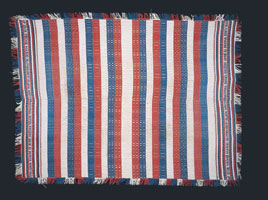Zora Mintalová
The table and tablecloth are two notions that undoubtedly belong to each other. The first tablecloths started to be used in Ancient Rome; they died with its fall. They then reappeared in feudal settlements in the 10th century. The table covered with a tablecloth represented the position of the man of the house, his power and the strength of his family. In the Middle Ages, the tablecloth was a sign of tranquillity and peace; cutting it meant starting a feud with a guest. On our territory, tablecloths were woven by art weavers during the 15th to 17th century. Embroidery started to appear in the decoration of tablecloths in the 15th century. Richly decorated, expensive tablecloths were embroidered in professional embroidery workshops. In noblemen circles, tablecloths were embroidered by simpler techniques on canvas. In the 16th century, a variety of small cloths started to be used. Between the 16th and 17th centuries, tablecloths appeared in the households of the rich burgesses. In the village environment these were only used during festive events, and they became widespread only in the first part of the 19th century. Tablecloths and decorative covers for tables have a long and interesting development from the point of view of materials, basic and decorative techniques, motifs and colour schemes.
